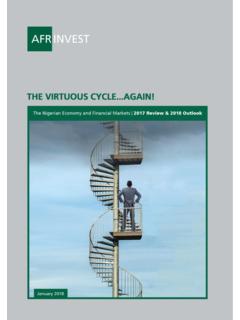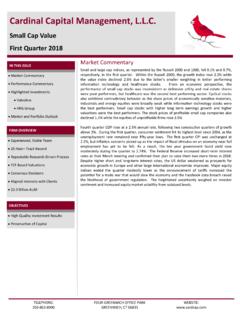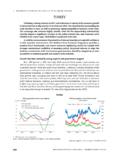Transcription of GERMANY - OECD.org
1 3. DEVELOPMENTS IN INDIVIDUAL OECD AND SELECTED NON-MEMBER ECONOMIESOECD ECONOMIC OUTLOOK, VOLUME 2018 ISSUE1 PRELIMINARY VERSION OECD 2018146 GERMANYE conomic growth is projected to remain solid, backed by robust world trade,investment and a booming labour market. Consumption growth has slowed somewhat,as higher inflation has curbed real wage growth. Low interest rates, high capacityutilisation and growing housing demand are supporting strong residential and businessinvestment. The current account surplus is projected to fall somewhat on the back ofstrong domestic demand that fuels policy is mildly expansionary, but strong cyclical revenue growth will keep thebudget balance in surplus.
2 Reductions in social security contributions and highersubsidies for families are expected, although their timing remains uncertain. Fiscalspace is available to increase spending on education, broadband and low-emissiontransport infrastructure, all of which would strengthen productivity in the long run. Taxreductions for low-wage and second earners along with higher environmental and realestate taxes would promote greener and more inclusive growth has been strongWith its specialisation in capital goods, GERMANY has benefitted from the broad-basedglobal upswing. In the context of high capacity utilisation and easy credit, this haspromoted strong machinery and equipment investment.
3 However, in the first quarter,strikes and an outbreak of influenza lowered manufacturing production spending also slowed before the new government took office in sentiment remains high notwithstanding a recent decline related to concernsabout rising protectionism. Immigration, rising household incomes and low interest rateshave boosted housing demand and construction. However, the construction sector hasnow reached capacity constraints, limiting faster growth going forward. House prices haveGermany1. Manufacturing, construction, wholesaling and The nominal house price is divided by the nominal disposable income per head.
4 It is standardised by being divided by the long-termaverage as a reference value over :Ifo Business Survey, May 2018; and OECD Housing Prices 2 2010 2011 2012 2013 2014 2015 2016 2017 Index 2015 = 100 Ifo Business ClimateAssessment of business situationBusiness expectationsIfo business climate index for Industry and Trade, Seasonally adjustedBusiness sentiment remains strong despite a recent drop708090100110707682889410010611219931 998200320082013 Index Standardised ratio of house prices to income.
5 Index average since 1980 = 100 House prices have been rising but remain below long run averages3. DEVELOPMENTS IN INDIVIDUAL OECD AND SELECTED NON-MEMBER ECONOMIESOECD ECONOMIC OUTLOOK, VOLUME 2018 ISSUE1 PRELIMINARY VERSION OECD 2018147 GERMANY :Demand, output and prices1 2 prices EUR billionGDP at market prices2 Private consumption1 Government consumption Gross fixed capital formation Final domestic demand2 Stockbuilding1- Total domestic demand2 Exports of goods and services1 Imports of goods and services1 Net exports1 Memorandum itemsGDP without working day GDP deflator Harmonised index of consumer prices
6 Harmonised index of core inflation2 Unemployment rate (% of labour force) Household saving ratio, net (% of disposable income) General government financial balance (% of GDP) General government gross debt (% of GDP) General government debt, Maastricht definition (% of GDP) Current account balance (% of GDP) 1. Contributions to changes in real GDP, actual amount in the first column. 2. Harmonised index of consumer prices excluding food, energy, alcohol and tobacco.
7 Source: OECD Economic Outlook 103 database. Percentage changes, volume(2010 prices)Germany1. Population aged 15-74 years. Based on the German labour force Percentage of unfilled job vacancies relative to total Average nominal wage per Harmonised consumer price index (HICP). Core HICP excludes energy, food, alcohol and tobacco. Projection from 2018Q2 for HICP andcore :OECD Economic Outlook 103 database; and Statistisches 2 2011 2012 2013 2014 2015 2016 2017% of labour force % of total employment Unemployment rate Job vacancy rate Seasonally and working day adjusted The labour market is tight01234 2013 2014 2015 2016 2017 2018 2019 Y o y % changesWage rate Headline inflation4 Core inflation4 Seasonally adjusted Wage and price inflation are projected to rise3.
8 DEVELOPMENTS IN INDIVIDUAL OECD AND SELECTED NON-MEMBER ECONOMIESOECD ECONOMIC OUTLOOK, VOLUME 2018 ISSUE1 PRELIMINARY VERSION OECD 2018148risen markedly, especially in urban areas, where the supply of buildable land is to affordable housing is increasingly difficult for lower and middle-incomehouseholds. But prices are still below long-run averages and mortgage lending has been inline with income growth, suggesting that financial risks remain employment gains have pushed the unemployment rate to a record low,while the number of vacant jobs has continued to rise, in particular in long-term care andconstruction. The booming labour market underpins consumption and helps improve jobquality and equality, as the number of full-time permanent contracts is growing stronglyand broad-based wage growth benefits particularly lower-income earners.
9 Employmentgrowth has been strongest for low-pay jobs with the lowest skill demands in recent years,mostly in health care as well as personal and administrative services, moderatingaggregate wage growth. Strong immigration, mostly from other EU countries, has also keptwages from rising more vigorously. Recent collective bargaining outcomes suggest amodest increase in wage growth. Unions and employers have negotiated non-wagebenefits, such as a better work-life balance through more possibilities to reduce theirworking time policy is addressing some key structural prioritiesThe fiscal stance is projected to be expansionary in 2018 and 2019.
10 The newgovernment has announced plans to reduce unemployment insurance contributions by point and to shift about percentage point of health insurance contributionsfrom employees to employers. Child tax allowances and benefits will also rise. Thegovernment also plans substantial tax rebates and grants for families with children whowant to buy a home. All of these measures will boost household demand. Governmentspending to better integrate refugees, improve childcare provision, upgrade schools digitalequipment and spur the rollout of high-speed broadband is expected to rise. Most of thesemeasures were announced in the government s coalition agreement.

















